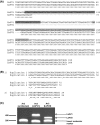Competitive outcome of multiple infections in a behavior-manipulating virus/wasp interaction
- PMID: 26811766
- PMCID: PMC4717342
- DOI: 10.1002/ece3.1749
Competitive outcome of multiple infections in a behavior-manipulating virus/wasp interaction
Abstract
Infections by multiple parasites are common in nature and may impact the evolution of host-parasite interactions. We investigated the existence of multiple infections involving the DNA virus LbFV and the Drosophila parasitoid Leptopilina boulardi. This vertically transmitted virus forces infected females to lay their eggs in already parasitized Drosophila larvae (a behavior called superparasitism), thus favoring its spread through horizontal transmission. Previous theoretical work indicated that the evolution of the level of the manipulation strongly depends on whether infected parasitoids can be re-infected or not. Here, we describe a strain of LbFV that differs from the reference strain by showing a deletion within the locus used for PCR detection. We used this polymorphism to test for the existence of multiple infections in this system. Viral strains did not differ on their vertical or horizontal transmission rates nor on the way they affect the parasitoid's phenotype, including their ability to manipulate behavior. Although already infected parasitoids were much less susceptible to new infection than uninfected ones, frequent coinfection was detected. However, following coinfection, competition between viral strains led to the rapid elimination of one strain or the other after a few generations of vertical transmission. We discuss the implications of these results for the evolution of the behavioral manipulation.
Keywords: Drosophila parasitoid; Leptopilina boulardi Filamentous Virus; coinfection; within‐host competition.
Figures






Similar articles
-
Additional heritable virus in the parasitic wasp Leptopilina boulardi: prevalence, transmission and phenotypic effects.J Gen Virol. 2016 Feb;97(2):523-535. doi: 10.1099/jgv.0.000360. Epub 2015 Dec 4. J Gen Virol. 2016. PMID: 26642803
-
Genome Sequencing of the Behavior Manipulating Virus LbFV Reveals a Possible New Virus Family.Genome Biol Evol. 2016 Dec 1;8(12):3718-3739. doi: 10.1093/gbe/evw277. Genome Biol Evol. 2016. PMID: 28173110 Free PMC article.
-
Molecular detection, penetrance, and transmission of an inherited virus responsible for behavioral manipulation of an insect parasitoid.Appl Environ Microbiol. 2009 Feb;75(3):703-10. doi: 10.1128/AEM.01778-08. Epub 2008 Dec 5. Appl Environ Microbiol. 2009. PMID: 19060167 Free PMC article.
-
A virus-shaping reproductive strategy in a Drosophila parasitoid.Adv Parasitol. 2009;70:333-63. doi: 10.1016/S0065-308X(09)70013-2. Adv Parasitol. 2009. PMID: 19773077 Review.
-
Immunogenetic aspects of the cellular immune response of Drosophilia against parasitoids.Immunogenetics. 2001;52(3-4):157-64. doi: 10.1007/s002510000272. Immunogenetics. 2001. PMID: 11220617 Review.
Cited by
-
A novel and diverse family of filamentous DNA viruses associated with parasitic wasps.Virus Evol. 2024 Mar 2;10(1):veae022. doi: 10.1093/ve/veae022. eCollection 2024. Virus Evol. 2024. PMID: 38617843 Free PMC article.
References
-
- Alizon, S. , and van Baalen M.. 2005. Emergence of a convex trade‐off between transmission and virulence. Am. Nat. 165:E155–E167. - PubMed
-
- Alizon, S. , Hurford A., Mideo N., and Van Baalen M.. 2009. Virulence evolution and the trade‐off hypothesis: history, current state of affairs and the future. J. Evol. Biol. 22:245–259. - PubMed
-
- Anderson, R. M. , and May R. M.. 1982. Coevolution of hosts and parasites. Parasitology 85: 411–426. - PubMed
-
- Ben‐Ami, F. , Mouton L., and Ebert D.. 2008. The effects of multiple infections on the expression and evolution of virulence in a Daphnia‐endoparasite system. Evolution 62:1700–1711. - PubMed
LinkOut - more resources
Full Text Sources
Other Literature Sources

